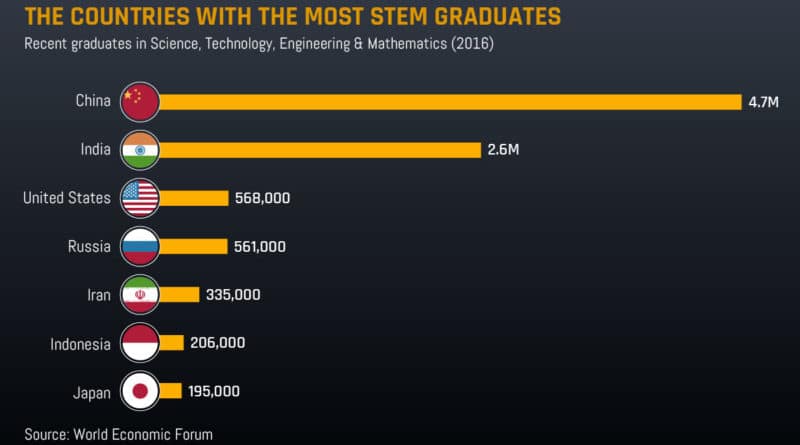STEM and the Future of Work
As the world’s leading economy, the U.S. is under pressure to produce the best minds to solve the greatest challenges facing mankind. The problem is, the United States is falling behind in some of the most important areas of education to help solve the problems of today and tomorrow. The crisis in STEM fields—which cover science, technology, engineering and mathematics—is threatening the growing workforce and in turn, the country’s position in the global economy.
While 86% of Americans believe that increasing the number of workers in STEM areas is vital for maintaining their position in the global economy, U.S. students are lagging behind academically. To combat this issue, STEM education and subsequent research programs were injected with more funding. New legislation also helped prioritize these subjects in the curriculum for kindergarten through high school.
According to Emsi, a modeler of economic data, undergraduates in STEM education increased by 43% between 2010 and 2016. However, despite the promising growth, 2.4 million STEM jobs went unfilled in 2018.
One possible reason for this? Advancing technologies such as artificial intelligence, quantum computing, and robotics require entirely new skill sets. Success in STEM jobs also relies on adapting to new situations and developing soft skills such as:
- Creativity and innovation
- Problem-solving and critical thinking
- Collaboration and leadership
As these technologies continue to evolve, having skills in STEM will be non-negotiable for employees and leaders the world over.
Threatening U.S. Economic Leadership
Statistics show that the U.S. is providing more opportunities for other countries to take the lead in STEM fields. For example, 62% of all international students in tertiary education in the U.S. are in science and engineering fields, with almost 70% of those students coming from India and China.
What’s more, over half of all U.S. patents go to foreign nationals and companies instead of Americans at home.
If America’s STEM proficiency continues to decline, not only will the skills gap be detrimental to the workforce, but it will also erode its potential future for economic and scientific leadership.
The Global STEM Leaders
According to the World Economic Forum, China is a major player in STEM education, boasting 4.7 million graduates as of 2016.
The country’s swift uptake of STEM initiatives is driven by new government policy, school participation, and parents’ increasing awareness of the benefits that will future proof the careers of their children.
The U.S. sits in third place with 568,000 STEM graduates, but compares closely with India on STEM graduates per population—1 to 52 in India and 1 to 57 in the United States. However, they’re still no match for China’s 1 to 29 ratio.
Narrowing the Skills Gap
If the U.S. is to become a global leader in STEM literacy, innovation, and employment, the Department of Education suggests that a STEM reform is needed, with the increase of diversity and inclusion being a top priority.
A significant opportunity for growth lies in making STEM more accessible for women—but while there has been a steady rise in women pursuing STEM careers, there are still systemic barriers in place that prohibit women from entering.
Experts also suggest that the introduction of STEM at an earlier age and educating students on the diversity of STEM careers are crucial elements in preparing a more capable workforce.
Given the recent demand for reform, it is clear that STEM education is key to thriving in the new technology-based economy and cultivating solutions to real world problems.
Information from an article by:
Katie Jones

